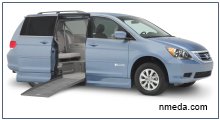Equipping Your Accessible Vehicle

The first step in adapting an accessible vehicle is to determine the equipment you need to ensure safety, comfort and enjoyment every time you drive.
Consulting with a representative from a vocational rehabilitation agency and/or specialist in transportation services for the mobility challenged will help determine your candidacy for driving, as well as the equipment and features best suited to your needs.
What alterations and devices are available?
The most common accessible car, truck, SUV and van devices include hand controls, wheelchair lifts, gear selectors, and driving systems. They can be quite expensive and some will not fit in just any van, truck or car.
Most vehicles are not built to withstand the intricate, heavy equipment needed for a person with limited mobility function. That’s why researching your options and evaluating your choices is essential to ensuring your satisfaction.
What are some modifications that can be made?
Typical modifications include raising the roof, lowering the floor, and
widening the entry. The extent of van, truck and car modifications
depends on the degree of physical and cognitive ability of the driver.
Where else can I find people who can help me?
It is always helpful to contact people “who have been there” to gain
important insights, ideas and referrals. Whenever possible, consult with
other disabled drivers who have been through the process of adapting a
van, truck or car.
If you do not know people to whom you can talk, contact your local Independent Living Center for names of individuals who have made similar purchases.
Additionally, physical therapists, mobility van retailers and other related companies may be willing to give you the names of their customers for follow-up purposes.
How do I choose a vendor to install equipment?
Here are some important questions to help you determine the best vendor to make your vehicle modification.
- What are your preferences and specific needs?
- How long will it take to begin and complete modifications to your vehicle?
- Is the vendor a member of the National Mobility Equipment Dealers Association (www.nmeda.com) or related group?
- What type of training has the staff received?
- What type of warranty will be provided?
- Does the company offer ongoing service and maintenance – and stock replacement parts?
Once a vendor is chosen, arrangements are made to transport the vehicle to the shop. Eventually you will have to visit and examine the custom fittings to assure proper placement of the equipment for your accessible vehicle.
Your involvement during the installation process is key because you do not want to discover, after you take your handicap accessible vehicle home, that the equipment is not adjusted correctly.
Incorrect adjustments may lead to discomfort or difficulty while driving, or even worse, greater potential of having an accident. The final step is to check out your vehicle and drive it home.
This article is an excerpt from a post on the topic by Susan Schaffer, MS Ed. For more information, visit her blog at www.infobilitysue.blogspot.com.
Related Information - Accessible Vehicle
Mobility Van Sales
Wheelchair and Mobility Ramps
Mobility Resources and Assistance
Converting a Wheelchair Accessible Van
Adapting a Handicap Accessible Vehicle
Buying a Used Wheelchair Van
Popular ArticlesTypes of Mobility Chairs Wheelchair Sports Activities Helpful Resource Organizations Mobility Scooter Buying Tips Portable Ramp Options |


